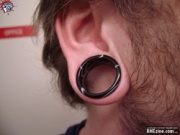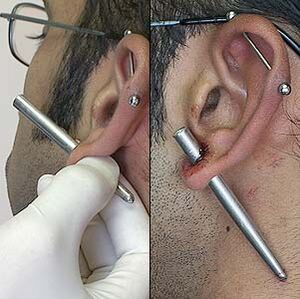Stretching
Stretching particularly when getting to larger sizes; can be a lot more extreme than you may think. It is far more time consuming than anything else in piercing, and requires far more commitment to the art and lifestyle.
Contents
Methods
As far as how stretching is done, it's simple — you merely put larger items in your piercing until you achieve the size you desire. As far at the methods go, they are quite varied and some can be quite unique, as you stretch, you will discover what is best by "listening to your body".
Starting with Large Gauge Piercings
Stretching should only be done on a fully healed piercing, but note that you can get a head-start on the process by beginning the piercing at a large gauge (using a scalpel, dermal punch, or large-gauge piercing needle for the initial piercing).
Contrary to popular belief, a needle does not remove tissue — it cuts a curved slit. Assuming that the body part is large enough, there is no real limit as to how large you can start. Given a sufficiently experienced piercer, an initial half-inch lobe heals as quickly as a 14ga lobe. Scalpels offer larger size holes, but also require more experience to use. For the average piercer, using a 6ga or 4ga needle is a reasonable upper limit.
Taper
The most common method for stretching is the Taper, a rod that increases at one end in diameter to allow the stretch to take place as it is inserted. These can be professionally manufactured Tapers (usually made of surgical stainless steel or acrylic) or it can be things you find around the house. You will very quickly learn what materials are appropriate for your body. Everything from stainless steel or aluminium; to wood, metal or plastic knitting needles.
Weights
Weights are a very popular way to stretch lobes for many people, but generally weights are not the best way to stretch a piercing as they can cause migration of the piercing and thinning of the tissue on the bottom of the piercing.
PTFE Tape
PTFE is a widely used method of stretching piercings, mainly lobes with plugs, by wrapping PTFE pipe tape around the plug and then reinserting it into the piercing. This allows small incremental increases in size as some bodies may find it difficult to adapt to larger change (ie: The difference from 0ga to 00ga is 2mm, a large size when talking in terms of stretching a piercing)
Bondage Tape
Bondage Tape is now becoming a more popular method of stretching; like PTFE tape it can be wrapped around the jewelry and reinserted into the piercing, the advantage of Bondage tape is it is slightly thicker and many find easier to work with than the thinner PTFE tape, it also; due to the thicker material, does not crease as much around the jewelry, meaning less buildup of dead skin cells (Ear Cheese). A knitting needle that has been cut down, is commonly used as the core for wrapping, with O-rings used to secure the taped "plug".
Permanency
Most people can stretch to at least 2ga (1/4") and still have the tissue return to normal when they remove the jewelry, however every body is unique and there are no guarantees. Most piercers will recommend you do not stretch your ears unless you are certain you'll be okay with it forever. Once the elastic limit of the skin has been passed, or a large amount of additional tissue has been built up, the hole will not close again completely. There are surgical procedures to rebuild one's earlobe once stretched however these are costly and generally only used as a last resort for those wishing for a lifestyle change where a stretched piercing is forbidden (ie: Entering the Military etc).
Caring for your Stretches & Warnings
Stretches should be cared for by cleaning regularly with soap, then massaging with one of a number of oils/creams. Jojoba, Extra Virgin Olive, and Emu Oils are three of the most popular, all are readily available and will speed healing process, and soften any developing scar tissue that may develop during the stretching process. Creams containing Vitamin E have also gained popularity, they nourish the skin allowing more and healthier skin cells to grow, potentially avoiding the 'thinning' effect discussed below.
If the skin around the piercing gets particularly thin, it is recommended that stretching ceases and the piercing is downsized to allow the tissue to thicken again and feeding it with a vitamin E cream/oil, then reinserting the larger jewelry/taper once the tissue is thicker and healthier. By repeating this process, you can usually drastically increase the thickness of the tissue. In addition, choice of jewelry material can have an effect on the tissue's thickness (and general health). Many people find the high quality wooden jewelry both thickens the tissue and keeps it healthy (and stink-free).
Most people can stretch about one inch per year. Over-stretching can result in tearing or migration, which will usually lead to scar tissue. The biggest problem with this is that it makes further stretching more difficult. Over-stretching can also result in damage to nerves, leading to a loss of feeling in the tissue. However, feeling typically returns in six to twelve months. Damage can also be done to blood vessels, resulting in a loss of circulation, in which case the tissue may die or become significantly weakened.
Another problem is the development of a "lip" behind the piercing. These blowout "lips" commonly appear around earlobe and other piercings that are stretched too quickly for the body to adapt. The simple way to get rid of them, if you catch them in time, is to downsize them immediately, and allow them to reabsorb. Folding or rotating the lip back inside the piercing and applying pressure to the outside with washers and O-rings, will sometimes help it assimilate back into the primary tissue. However, this doesn't always work. The more advanced way to get rid of them is to physically remove them. One method that has been met with good success is tightly tying off the lip (using a tunnel as a backing), allowing the tissue to die, and then removing it.
Trivia
- A person who is either obsessed with stretching their piercings, or with showing off their many stretched piercings, is known as a "Gauge Queen". Some wear this term with pride, others use it derisively.
- Referring to stretched ear lobes as "gauges" is a misnomer and incorrect. A gauge is a unit of measurement and it is incorrect to refer to stretched ear lobes or the jewellery as "ear gauges" as this makes no sense (it is akin to calling them "ear inches").
Jewelry
A variety of jewelry is available for stretched earlobe piercings. Types of jewelry available include plugs, eyelets, and large captive bead rings, as well as hanging styles. Majority of professionals agreed that the best jewellery to wear in a stretched lobe, is something organic such as bone, wood or stone. These materials relieve the wearer from lobe funk and smell.
If the jewelry is removed from the piercing, the hole will shrink in diameter over the course of weeks and months. The amount a stretched earlobe will shrink if jewelry is removed long-term is dependent on the specific person pierced, and it's impossible to give an exact amount that will apply to everyone. Please note, however, that it's generally accepted that a piercing stretched to 4 gauge or over is not likely to shrink to the point it won't be noticeable. Earlobes which have been scalpelled or punched will typically not shrink beyond the size they were when the procedure was performed.

